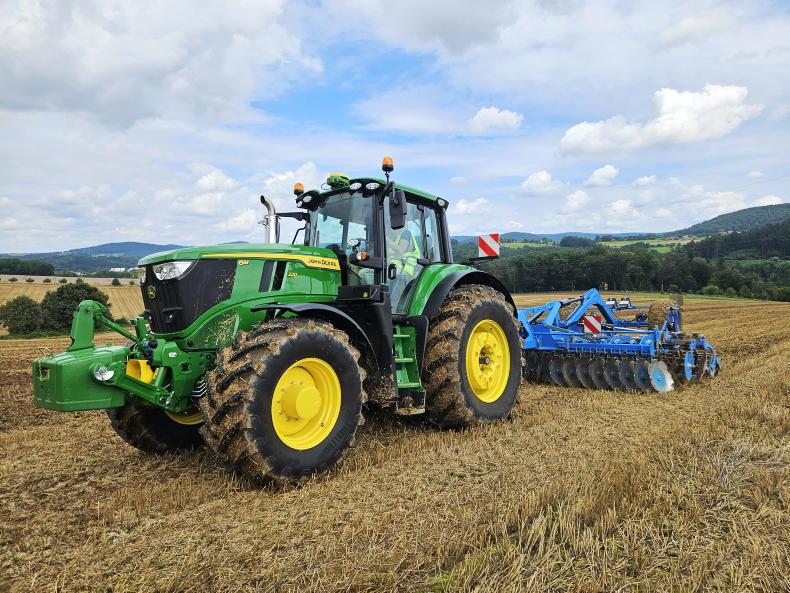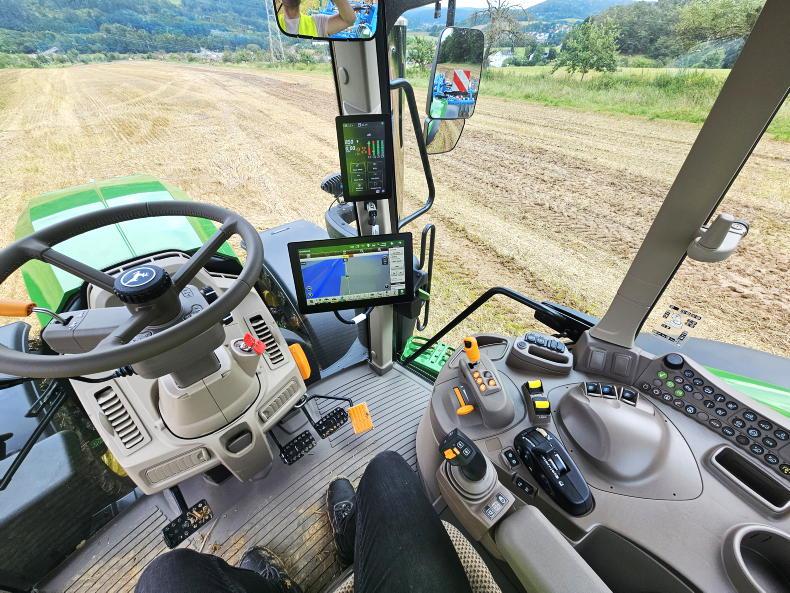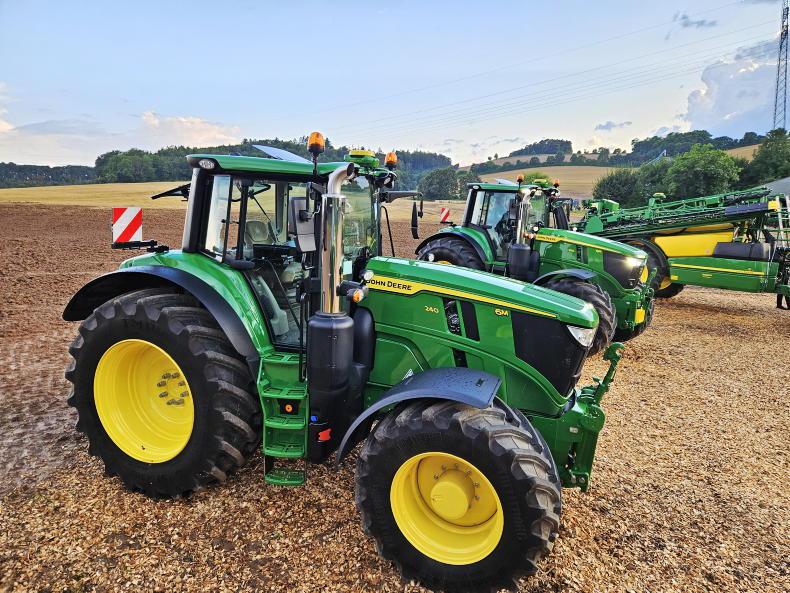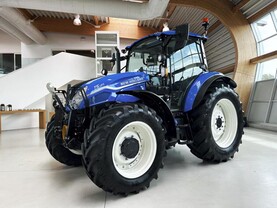Earlier this summer, news broke that John Deere was in the midst of turning out a new revamped 6M tractor series.
John Deere first introduced the 115hp to 170hp 6M series in 2012.
The series was the more standard and basic no frills range, initially targeted towards livestock and mixed farms not requiring a 50km/h transmission, or the larger, more premium R-series cab.
Evolution of the 6M
As time moves on and some customer preferences change, the series continues to evolve in-line. Today, the horsepower offering of the new 6M is almost in line with 6R series.
The physical factors that differentiated the two ranges are narrowing. For example, both ranges use the same chassis, the same engines and now the same transmissions.
The only exception being that Command Quad is only available on the 6M, and Direct Drive is only available on the 6R.
There are still considerable differences when it comes to specification, mainly in terms of in-cab refinements. As the 6M continues to evolve after 12 years, it has done so in keeping with customer requirements, as we move into an era more focused on technology and increasing horsepower.
Up to now, the big differences between the 6M and the 6R were that AutoPowr continuously variable transmission (CVT) and 50km/h road speed were limited to the 6R, while the cabs were also different.
With the revamped 6M, spec for spec, the only real difference is the cab, coupled with a slightly smaller hydraulic output and a reduced number of spool valves. 
The option of upgrading to a 50km/h transmission will be widely welcomed, while the option of the AutoPowr stepless transmission will be appreciated by a cohort.
The model line-up
The significantly expanded model line-up now comes in 17 models, including 10 above 150hp. The range starts with the compact 6M 95, and tops out with the 6M 250, spanning five frame-size segments.
The first seven models are four-cylinder (6M 95, 6M 105, 6M 115, 6M 125, 6M 130, 6M 140 and 6M 150). The first four models come in the 2,400mm (short frame) and the other three come in the 2,580mm (small frame).
The noteworthy addition is the high-horsepower four-cylinder 6M 150, which now boosts to 177hp with the newly introduced IPM (Intelligent Power Management) engine boost system.
This is now John Deere’s highest powered four-cylinder option. All four-cylinder models feature the same 4.5 litre engine, with all models benefitting from the additional up to 20hp IPM boost, which kicks in on transport or PTO applications.
The 10 larger models are all six-cylinder, and include the 6M 145, 6M 155, 6M 165, 6M 185, 6M 180, 6M 200, 6M 220, 6M 230 6M 240 and the 6M 250.
The first four models come in the 2,765mm (mid frame) the next four come in the 2,800mm (large frame) and the final two largest models come in the 2,900mm (extra-large frame).
Despite the plethora of new models, the notable additions are the upgraded 6M 145, which now comes with six cylinders instead of four and the 6M 230 and 6M 250 models which feature the extra-large frame at the top end (same frame as 6R 230 and 6R 250).
All six-cylinder models feature the same 6.8 litre engine, with all models also benefitting from the additional 20-40hp IPM boost. 
John Deere said the 6120M has been its most sold model across all ranges in Europe for the past four years running, and it believes the 6M 125 will continue to do so.
Transmission options
Up to now, the 6M range could be equipped with the PowrQuad Plus, AutoQuad Plus or the Command Quad Plus transmission for slightly enhanced automatic capabilities, which are all essentially the same form of mechanical box, which has proven itself time in time out.
The new 6M now comes with the option of John Deere’s AutoPowr stepless transmission. This means that with the new range, the only exception is that Command Quad is only available on the 6M, and Direct Drive is only available on the 6R.
Meanwhile, the Command PRO joystick control system, which is offered alongside the AutoPowr transmission, is only also available on the 6R.
One point to note is that the 6M 150, 6M 185, 6M 230, 6M 240 and 6M 250 are only available with AutoPowr.
The range is now optionally available in 50km/h variants, which will be widely accepted, particularly from those using the 6M as a haulage tractor. Deere anticipates that in the region of 65-70% of the new six-cylinder 6Ms will be ordered in 50km/h.
Cab
As the 6M and 6R grow closer in specification, the big difference remains the cab. The 6M cab is a bit smaller than the 6R, and essentially is the same cab frame that John Deere used in its 20 and 30 series tractors that were offered from 2002 through to 2012.
Inside, the cab remains quite similar too, with the exception of some updated trimming and styling.
One thing the 6M cab gains with the latest revamp is the new corner post display that is larger and fully graphical, allowing users to adjust more tractor settings than before.
The new coloured corner post display is located on the right-hand side A-post, and provides operators with an easy to adjust overview of key tractor functions such as fuel and AdBlue levels, engine temperature, engine speed, forward speed and air pressure.
It is also used to make adjustments to hydraulic flow rates etc, and can be used to assign spool valves to the optional control joystick, which is a popular choice on many 6M models nowadays. The new series features more customisable control functions, offering a choice between a right-hand console or the compact Command Arm for more tailored operation.
Maximum visibility is now facilitated by a panoramic roof and a larger glass area.
In terms of ride comfort, the front axle is fitted with the proven TLS (Triple-Link Suspension Plus) front axle suspension.
Meanwhile, the cab is equipped with mechanical cab suspension, in comparison to the 6R, which is fitted with hydraulic cab suspension.
From an in-depth conversation we had with John Deere’s Mid Tractor Product Specialist, he was confident that the latest mechanical cab suspension has come on in leaps and bounds in recent years, and today isn’t that far away from pneumatic suspension systems. 
The trusty AutoQuad Plus transmission.
Precision farming
John Deere acknowledged the high uptake of its precision technology equipment such as AutoTrac automated steering, which was first introduced back in 2002.
However, it still says it’s a growing area of the company’s business and that there are many farmers and contractors who are yet to tap into the technology.
With the new 6M, buyers can opt for the high-resolution 10.1” G5 or the 12.8” G5 Plus Universal Display. These are the latest display screens which Deere uses on its 6R, 7R, 8R and 9R-series tractors.
Through this display, operators can seamlessly connect their IsoBus implement and utilise John Deere Precision Ag Technology. It allows users to run precision farming features like its AutoTrac automatic steering system, section control, and variable rate application.
Data Sync also enables wireless sharing of field data and guidance lines between machines, which helps to streamline operations in bigger fleets.
The integration of JD-Link, which lets you remotely track where your machines are working and their live data, provides remote operator support.
It also ensures new models receive the latest over-the-air software updates.
The Command Quad Plus transmission for slightly enhanced automatic capabilities
6M capacities
With the same frame and chassis as the 6R, it means the 6M has the same physical abilities. In terms of hydraulics, all four-cylinder 6M models feature a flow rate of 80 l/min as standard or optionally 114 l/min.
Mid and large frame six-cylinder models feature a flow rate of 114 l/min as standard or optionally 155 l/min. Meanwhile, the top two flagship extra-large frame models can be equipped with larger hydraulic pumps delivering up to 195 l/min for running larger implements. Electric or manual spools are available, with the 6M featuring slightly fewer rear spool valve options over the 6R (four vs six).
The new 6M also comes with more and larger tyre options (42in rear rims) for a larger footprint on the field and a broader portfolio of axle options, including flange and rack-and-pinion axles.
It offers a rear-hitch lift capacity from 5.7 t to 9.9t. Buyers of the previous generation of 6M will be aware it was limited to either front axle braking or being AutoTrac steering ready, but this is no longer the case.
The 6M range now also comes with the option of a factory fitted reversible fan.
With the same frame and chassis as the 6R, it means the 6M has the same physical abilities.
Targeting a new market segment
John Deere is known to be a premium tractor manufacturer, but it’s more basic 6M has been a massive hit. For example, the no frills 6M has been a very important part of the Deere family since its introduction.
Deere said that the 6120M has been its most sold model across all ranges in Europe for the past four years running.
With the addition of some minor yet notable updates such as the move to the 50km/h transmission, John Deere expects that it will be able to capture a share of the market where it couldn’t match like with like offerings from competitor manufacturers, at a similar price point. 
The new range will be going into full production in November this year.
Pricing- 6M vs 6R
With all the additional spec, comes additional cost, and the age-old argument of buying a 6M vs a 6R comes into play once again.
Naturally, the big question potential buyers will have when they read about the new 6M range is how do they price against the 6R?
We took the popular sized 6M 155 and put it up against the comparable 6R 155. Bare in mind, the chassis, axles, engines and tyres sizes are the same, and we spec’d both with an AutoQuad 50km/h transmission.
As can be seen from the adjacent table, it came to a list price differential of €29,684 plus VAT. In terms of actually standing in a dealer’s yard with the finance man on standby, at a guess, that would more than likely equate to a variation of around €18,000 plus VAT. With these two relatively basic spec tractors, the only real difference is the cab.
With the updated styling, from a distance you wouldn’t notice the difference between the 6R and the revamped 6M. It’s only when you get up close that you will spot the narrower cab and the minor differentiating features.
The option of upgrading to a 50km/h transmission will be widely welcomed, while the option of the AutoPowr stepless transmission will be appreciated by a cohort.
Realistically, most tractor users in Ireland will be able to get everything they need from the latest 6M series, but the move to a 6R will be based on personal preferences and the slightly better room and improved comfort of the 6R cab.
Contractors who use the John Deere 6R for haulage work such as drawing silage and slurry will surely be tempted to move to the 6M with its updated spec, as will buyers of new tractors who carry out less frequent work.
For these types of customers, the price differential from a practicality point of view will have to be closely considered. However, you would be led to believe that the majority of owner-operators will still be drawn to the slightly more premium 6R.
When will we see the new 6M in Ireland?
The new range is now available to order, and will be going into full production in November this year.
John Deere says that it’s hoping to have units in dealers’ yards across the country in the first quarter of 2025.
Earlier this summer, news broke that John Deere was in the midst of turning out a new revamped 6M tractor series.
John Deere first introduced the 115hp to 170hp 6M series in 2012.
The series was the more standard and basic no frills range, initially targeted towards livestock and mixed farms not requiring a 50km/h transmission, or the larger, more premium R-series cab.
Evolution of the 6M
As time moves on and some customer preferences change, the series continues to evolve in-line. Today, the horsepower offering of the new 6M is almost in line with 6R series.
The physical factors that differentiated the two ranges are narrowing. For example, both ranges use the same chassis, the same engines and now the same transmissions.
The only exception being that Command Quad is only available on the 6M, and Direct Drive is only available on the 6R.
There are still considerable differences when it comes to specification, mainly in terms of in-cab refinements. As the 6M continues to evolve after 12 years, it has done so in keeping with customer requirements, as we move into an era more focused on technology and increasing horsepower.
Up to now, the big differences between the 6M and the 6R were that AutoPowr continuously variable transmission (CVT) and 50km/h road speed were limited to the 6R, while the cabs were also different.
With the revamped 6M, spec for spec, the only real difference is the cab, coupled with a slightly smaller hydraulic output and a reduced number of spool valves. 
The option of upgrading to a 50km/h transmission will be widely welcomed, while the option of the AutoPowr stepless transmission will be appreciated by a cohort.
The model line-up
The significantly expanded model line-up now comes in 17 models, including 10 above 150hp. The range starts with the compact 6M 95, and tops out with the 6M 250, spanning five frame-size segments.
The first seven models are four-cylinder (6M 95, 6M 105, 6M 115, 6M 125, 6M 130, 6M 140 and 6M 150). The first four models come in the 2,400mm (short frame) and the other three come in the 2,580mm (small frame).
The noteworthy addition is the high-horsepower four-cylinder 6M 150, which now boosts to 177hp with the newly introduced IPM (Intelligent Power Management) engine boost system.
This is now John Deere’s highest powered four-cylinder option. All four-cylinder models feature the same 4.5 litre engine, with all models benefitting from the additional up to 20hp IPM boost, which kicks in on transport or PTO applications.
The 10 larger models are all six-cylinder, and include the 6M 145, 6M 155, 6M 165, 6M 185, 6M 180, 6M 200, 6M 220, 6M 230 6M 240 and the 6M 250.
The first four models come in the 2,765mm (mid frame) the next four come in the 2,800mm (large frame) and the final two largest models come in the 2,900mm (extra-large frame).
Despite the plethora of new models, the notable additions are the upgraded 6M 145, which now comes with six cylinders instead of four and the 6M 230 and 6M 250 models which feature the extra-large frame at the top end (same frame as 6R 230 and 6R 250).
All six-cylinder models feature the same 6.8 litre engine, with all models also benefitting from the additional 20-40hp IPM boost. 
John Deere said the 6120M has been its most sold model across all ranges in Europe for the past four years running, and it believes the 6M 125 will continue to do so.
Transmission options
Up to now, the 6M range could be equipped with the PowrQuad Plus, AutoQuad Plus or the Command Quad Plus transmission for slightly enhanced automatic capabilities, which are all essentially the same form of mechanical box, which has proven itself time in time out.
The new 6M now comes with the option of John Deere’s AutoPowr stepless transmission. This means that with the new range, the only exception is that Command Quad is only available on the 6M, and Direct Drive is only available on the 6R.
Meanwhile, the Command PRO joystick control system, which is offered alongside the AutoPowr transmission, is only also available on the 6R.
One point to note is that the 6M 150, 6M 185, 6M 230, 6M 240 and 6M 250 are only available with AutoPowr.
The range is now optionally available in 50km/h variants, which will be widely accepted, particularly from those using the 6M as a haulage tractor. Deere anticipates that in the region of 65-70% of the new six-cylinder 6Ms will be ordered in 50km/h.
Cab
As the 6M and 6R grow closer in specification, the big difference remains the cab. The 6M cab is a bit smaller than the 6R, and essentially is the same cab frame that John Deere used in its 20 and 30 series tractors that were offered from 2002 through to 2012.
Inside, the cab remains quite similar too, with the exception of some updated trimming and styling.
One thing the 6M cab gains with the latest revamp is the new corner post display that is larger and fully graphical, allowing users to adjust more tractor settings than before.
The new coloured corner post display is located on the right-hand side A-post, and provides operators with an easy to adjust overview of key tractor functions such as fuel and AdBlue levels, engine temperature, engine speed, forward speed and air pressure.
It is also used to make adjustments to hydraulic flow rates etc, and can be used to assign spool valves to the optional control joystick, which is a popular choice on many 6M models nowadays. The new series features more customisable control functions, offering a choice between a right-hand console or the compact Command Arm for more tailored operation.
Maximum visibility is now facilitated by a panoramic roof and a larger glass area.
In terms of ride comfort, the front axle is fitted with the proven TLS (Triple-Link Suspension Plus) front axle suspension.
Meanwhile, the cab is equipped with mechanical cab suspension, in comparison to the 6R, which is fitted with hydraulic cab suspension.
From an in-depth conversation we had with John Deere’s Mid Tractor Product Specialist, he was confident that the latest mechanical cab suspension has come on in leaps and bounds in recent years, and today isn’t that far away from pneumatic suspension systems. 
The trusty AutoQuad Plus transmission.
Precision farming
John Deere acknowledged the high uptake of its precision technology equipment such as AutoTrac automated steering, which was first introduced back in 2002.
However, it still says it’s a growing area of the company’s business and that there are many farmers and contractors who are yet to tap into the technology.
With the new 6M, buyers can opt for the high-resolution 10.1” G5 or the 12.8” G5 Plus Universal Display. These are the latest display screens which Deere uses on its 6R, 7R, 8R and 9R-series tractors.
Through this display, operators can seamlessly connect their IsoBus implement and utilise John Deere Precision Ag Technology. It allows users to run precision farming features like its AutoTrac automatic steering system, section control, and variable rate application.
Data Sync also enables wireless sharing of field data and guidance lines between machines, which helps to streamline operations in bigger fleets.
The integration of JD-Link, which lets you remotely track where your machines are working and their live data, provides remote operator support.
It also ensures new models receive the latest over-the-air software updates.
The Command Quad Plus transmission for slightly enhanced automatic capabilities
6M capacities
With the same frame and chassis as the 6R, it means the 6M has the same physical abilities. In terms of hydraulics, all four-cylinder 6M models feature a flow rate of 80 l/min as standard or optionally 114 l/min.
Mid and large frame six-cylinder models feature a flow rate of 114 l/min as standard or optionally 155 l/min. Meanwhile, the top two flagship extra-large frame models can be equipped with larger hydraulic pumps delivering up to 195 l/min for running larger implements. Electric or manual spools are available, with the 6M featuring slightly fewer rear spool valve options over the 6R (four vs six).
The new 6M also comes with more and larger tyre options (42in rear rims) for a larger footprint on the field and a broader portfolio of axle options, including flange and rack-and-pinion axles.
It offers a rear-hitch lift capacity from 5.7 t to 9.9t. Buyers of the previous generation of 6M will be aware it was limited to either front axle braking or being AutoTrac steering ready, but this is no longer the case.
The 6M range now also comes with the option of a factory fitted reversible fan.
With the same frame and chassis as the 6R, it means the 6M has the same physical abilities.
Targeting a new market segment
John Deere is known to be a premium tractor manufacturer, but it’s more basic 6M has been a massive hit. For example, the no frills 6M has been a very important part of the Deere family since its introduction.
Deere said that the 6120M has been its most sold model across all ranges in Europe for the past four years running.
With the addition of some minor yet notable updates such as the move to the 50km/h transmission, John Deere expects that it will be able to capture a share of the market where it couldn’t match like with like offerings from competitor manufacturers, at a similar price point. 
The new range will be going into full production in November this year.
Pricing- 6M vs 6R
With all the additional spec, comes additional cost, and the age-old argument of buying a 6M vs a 6R comes into play once again.
Naturally, the big question potential buyers will have when they read about the new 6M range is how do they price against the 6R?
We took the popular sized 6M 155 and put it up against the comparable 6R 155. Bare in mind, the chassis, axles, engines and tyres sizes are the same, and we spec’d both with an AutoQuad 50km/h transmission.
As can be seen from the adjacent table, it came to a list price differential of €29,684 plus VAT. In terms of actually standing in a dealer’s yard with the finance man on standby, at a guess, that would more than likely equate to a variation of around €18,000 plus VAT. With these two relatively basic spec tractors, the only real difference is the cab.
With the updated styling, from a distance you wouldn’t notice the difference between the 6R and the revamped 6M. It’s only when you get up close that you will spot the narrower cab and the minor differentiating features.
The option of upgrading to a 50km/h transmission will be widely welcomed, while the option of the AutoPowr stepless transmission will be appreciated by a cohort.
Realistically, most tractor users in Ireland will be able to get everything they need from the latest 6M series, but the move to a 6R will be based on personal preferences and the slightly better room and improved comfort of the 6R cab.
Contractors who use the John Deere 6R for haulage work such as drawing silage and slurry will surely be tempted to move to the 6M with its updated spec, as will buyers of new tractors who carry out less frequent work.
For these types of customers, the price differential from a practicality point of view will have to be closely considered. However, you would be led to believe that the majority of owner-operators will still be drawn to the slightly more premium 6R.
When will we see the new 6M in Ireland?
The new range is now available to order, and will be going into full production in November this year.
John Deere says that it’s hoping to have units in dealers’ yards across the country in the first quarter of 2025.












 This is a subscriber-only article
This is a subscriber-only article









SHARING OPTIONS: